Old Man Cactus (Cephalocereus Senilis) Profile
Written by Iris
Oct 11 2021
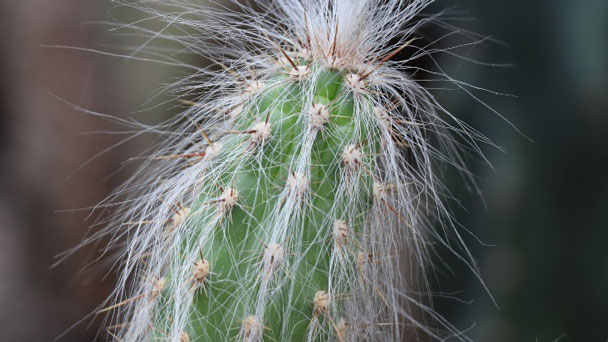
Old Man Cactus (Cephalocereus senilis) is covered in thick, soft white hair, so much so that its cylindrical stems are often completely obscured. Don't give in to the temptation to stroke its soft fur, though, as the dense wool hides some pretty wicked thorns. Old Man Cactus (Cephalocereus senilis) grows so slowly that it can reach ceiling height, but over decades. Old Man Cactus (Cephalocereus senilis) is unlikely to bloom indoors.
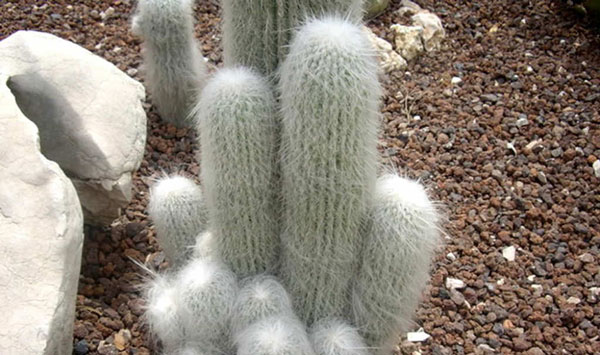
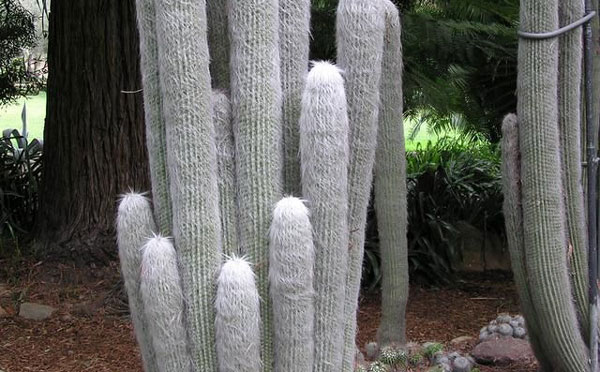
Most of the time, this can be accomplished by gently uprooting one or more offsets from the clump. You can use your hands, as long as you wear protective clothing, or you can cut the roots with a sharp, clean knife.
Once you’ve separated the offsets, allow them to dry out in the open air for several days. When you break or cut them away from the mother plant, you’re introducing open wounds, which are at risk of infection by bacteria or fungi.
The drying process allows those open wounds to callous, which will help prevent infection and give the offsets a better chance of survival.
Once the cuts have calloused, you can safely plant the offsets in new containers. After they’ve been transplanted, caring for the offsets is as simple as caring for mature cephalocereus senilis.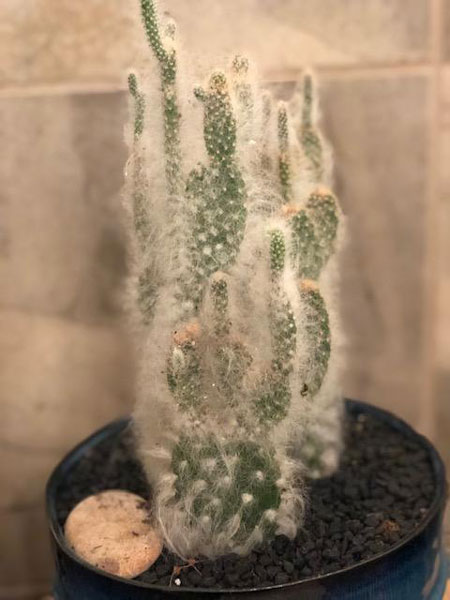

Because of its exceptional appearance, the Old Man Cactus has become a favorite houseplant. However, it is currently listed as an endangered species in its natural habitat so poaching is extremely prohibited. Plants available in the market are produced from propagation instead.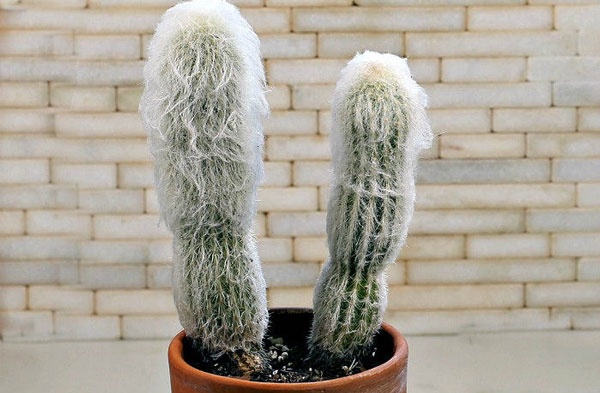
Cephalocereus senilis, also called Old Man Cactus, Bunny Cactus, or White Persian Cat Cactus is a columnar cactus native to Mexico, especially Guanajuato and Hidalgo. This succulent species has distinctive long white hair covering the cylindrical, light to bright green stem.
Cephalocereus hoppenstedtii
Cephalocereus hoppenstedtii, known also as Cephalocereus columna-trajani or torch cactus, is a columnar arborescent cactus that can reach 6 to 10 m in height. This Cephalocereus species has a slender, cylindrical stem with 16-20 ribs hidden under numerous spines.
Cephalocereus palmeri
Cephalocereus palmeri, also named Hairy Cereus Tree Cactus, is a beautiful cactus native to Eastern Mexico. This cactus tree has a slender stem that is greenish when young, then taking on a more bluish tint which contrasts well with the white bristles.
Cephalocereus lanuginosus
Cephalocereus lanuginosus is a stunning cactus native to northern South America and the Caribbean. This cactus has a columnar green-blue stem with slender branches. Also, the stem has golden-yellow spines that turn grey with age. Because of its upright growth, it is great for indoors and doesn't take up much space.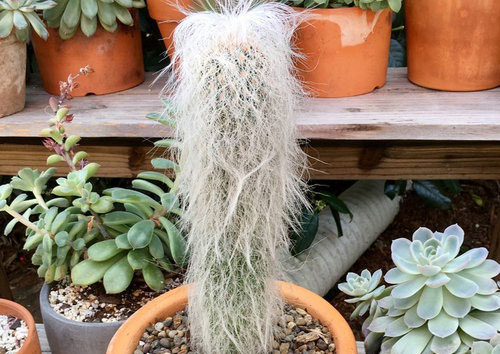
When checking your Old Man Cactus for pests, you'll need to cautiously search under the hair while avoiding the sharp spines hidden among the fluff.
Detecting white, fuzzy pests like mealybugs or the webs of spider mites can be especially difficult, so it’s important to examine your plant closely if you suspect an infestation.
Fortunately, dealing with pests on cephalocereus senilis isn’t any more difficult than treating the problem on other cacti. This is especially true if you can catch the infestation in its early stages.
However, if you’re applying a topical treatment to the Old Man Cactus, you'll need to be sure that the treatment is reaching the cactus itself and isn't just sitting atop the hair.
Old Man Cactus PictureOld Man Cactus InfoOld Man Cactus Ecological HabitsOld Man Cactus DistributionHow to Grow and Care for Old Man CactusHow to Grow Old Man CactusHow to Care for Old Man Cactus Old Man Cactus UsesTypes of Old Man CactusOld Man Cactus Common Pests/DiseasesOld Man Cactus Design Tips
Old Man Cactus Picture

Old Man Cactus Info
| Scientific Name | Cephalocereus senilis |
| Common Name | Old Man Cactus |
| Genus | Cephalocereus |
| Family | Cactaceae |
| Sunlight | Full sun |
| Height | 15 meters |
| Growth Rate | Slow |
| Hardiness | -10°F |
Old Man Cactus Ecological Habits
The slow-growing cactus reaches about twenty feet or more in its native habitat, producing many columnar stems that are usually un-branched. Its species name, senilis, comes from the Latin word meaning old man. As the name implies, it has grayish-white, distinctive, long, wooly hairs that look like a beard. The hairs cover the plant to protect it from scorching summer temperatures and to provide warmth in the winter. Its shaggy coat of hair conceals many tiny, sharp, yellow spines. In springtime, it produces two-inch-long, whitish-pink flowers that open at night. At maturity, following the blooms, the plant develops pinkish-red fruit that is covered with yellowish hair.Old Man Cactus Distribution
Old Man Cactus (Cephalocereus senilis) is a species of cactus native to Guanajuato and Hidalgo in eastern Mexico. It is threatened in the wild, but widespread propagation and popularity in cultivation have reduced the demand on wild populations. The species is one of the dominant elements of the xerophile scrub where it grows and it is restricted to calcareous canyons within xerophile vegetation.
How to Grow and Care for Old Man Cactus
How to Grow Old Man Cactus
- Propagate old man cactus with Seeds
- Propagate Old Man Cactus with Cuttings
- Propagate Old Man Cactus with Offsets
Most of the time, this can be accomplished by gently uprooting one or more offsets from the clump. You can use your hands, as long as you wear protective clothing, or you can cut the roots with a sharp, clean knife.
Once you’ve separated the offsets, allow them to dry out in the open air for several days. When you break or cut them away from the mother plant, you’re introducing open wounds, which are at risk of infection by bacteria or fungi.
The drying process allows those open wounds to callous, which will help prevent infection and give the offsets a better chance of survival.
Once the cuts have calloused, you can safely plant the offsets in new containers. After they’ve been transplanted, caring for the offsets is as simple as caring for mature cephalocereus senilis.

How to Care for Old Man Cactus
- Light Care
- Soil Care
- Water Care
- Temperature and Humidity Care
- Fertilizer Care
- Pruning Care

Old Man Cactus Uses
The woolly spines and striking white color of the Old Man Cactus (Cephalocereus senilis) easily make it a strong accent in the garden. Together with rounded and columnar cactuses, this plant will create a statement in a desert-themed landscape. It is also a distinctive addition to an indoor collection of cacti.Because of its exceptional appearance, the Old Man Cactus has become a favorite houseplant. However, it is currently listed as an endangered species in its natural habitat so poaching is extremely prohibited. Plants available in the market are produced from propagation instead.

Types of Old Man Cactus
Cephalocereus senilisCephalocereus senilis, also called Old Man Cactus, Bunny Cactus, or White Persian Cat Cactus is a columnar cactus native to Mexico, especially Guanajuato and Hidalgo. This succulent species has distinctive long white hair covering the cylindrical, light to bright green stem.
Cephalocereus hoppenstedtii
Cephalocereus hoppenstedtii, known also as Cephalocereus columna-trajani or torch cactus, is a columnar arborescent cactus that can reach 6 to 10 m in height. This Cephalocereus species has a slender, cylindrical stem with 16-20 ribs hidden under numerous spines.
Cephalocereus palmeri
Cephalocereus palmeri, also named Hairy Cereus Tree Cactus, is a beautiful cactus native to Eastern Mexico. This cactus tree has a slender stem that is greenish when young, then taking on a more bluish tint which contrasts well with the white bristles.
Cephalocereus lanuginosus
Cephalocereus lanuginosus is a stunning cactus native to northern South America and the Caribbean. This cactus has a columnar green-blue stem with slender branches. Also, the stem has golden-yellow spines that turn grey with age. Because of its upright growth, it is great for indoors and doesn't take up much space.

Old Man Cactus Common Pests/Diseases
Old Man Cactus (Cephalocereus senilis) isn't any more prone to common succulent pests than any other species of cactus, but it can be more difficult to detect pests because of the hair. While it would be nice if pests lived on the outside of the hair, so they'd be easier to see, that's not where the food source is.When checking your Old Man Cactus for pests, you'll need to cautiously search under the hair while avoiding the sharp spines hidden among the fluff.
Detecting white, fuzzy pests like mealybugs or the webs of spider mites can be especially difficult, so it’s important to examine your plant closely if you suspect an infestation.
Fortunately, dealing with pests on cephalocereus senilis isn’t any more difficult than treating the problem on other cacti. This is especially true if you can catch the infestation in its early stages.
However, if you’re applying a topical treatment to the Old Man Cactus, you'll need to be sure that the treatment is reaching the cactus itself and isn't just sitting atop the hair.
Old Man Cactus Design Tips
Old Man Cactus (Cephalocereus senilis) is a very popular cactus in warm climate desert gardening, grown for its woolly appearance. It is great for inexperienced gardeners and those that like low maintenance gardens, but this cacti is a frost tender. In colder climates, it is recommended to be keep in a container that can be taken outside for the summer and easily moved indoors for the winter. It is a very drought and heat tolerant. These facts are making it a stunning xeric landscape plant where it can reach its largest, most impressive size. This cacti has sharp thorns. Plant them away from play areas and pathways. Wear gloves and protective eyewear when handling cactus plants.Latest Updated
- Benefits of Bugleweed - 7 Science-backed Health Benefits
- Bugleweed Dangers & Side Effects - Is It Poisonous?
- How to Plant Evergreen Trees - What You Should Know
- When to Plant Evergreens - Grow Guide for Evergreen Trees
- 12 Wonderful Evergreen Shrubs for Your Garden
- 12 Popular Evergreen Plants with Pictures for Beginners
- When And How To Prune A Lilac Bush Like a Pro
- How to Grow & Care for Lilac Vine (Hardenbergia Violacea)
- Japanese Lilac Tree (Syringa Reticulata) Care & Propagation Guide
- Shumard Oak Pros and Cons - What to Know
Popular Articles
- Winter maintenance of Antirrhinum Majus
- How to Grow Terminalia Mantaly Tree
- How to Grow and Care for Crossostephium Chinense
- How to grow Antirrhinum Majus in spring
- Peristeria Elata (Dove Orchid) Profile: Info & Care Guide
- Underwatered Snake Plant (Sansevieria Trifasciata) - Signs And How To Fix
- How to Care for Brazilian Jasmine Plant (Mandevilla Sanderi)
- How to Grow & Care for Graptopetalum Purple Delight in Summer
- Rosa Chinensis (China Rose): Plant Growing & Care Tips
- How to Care for Baby Sun Rose (Aptenia Cordifolia)